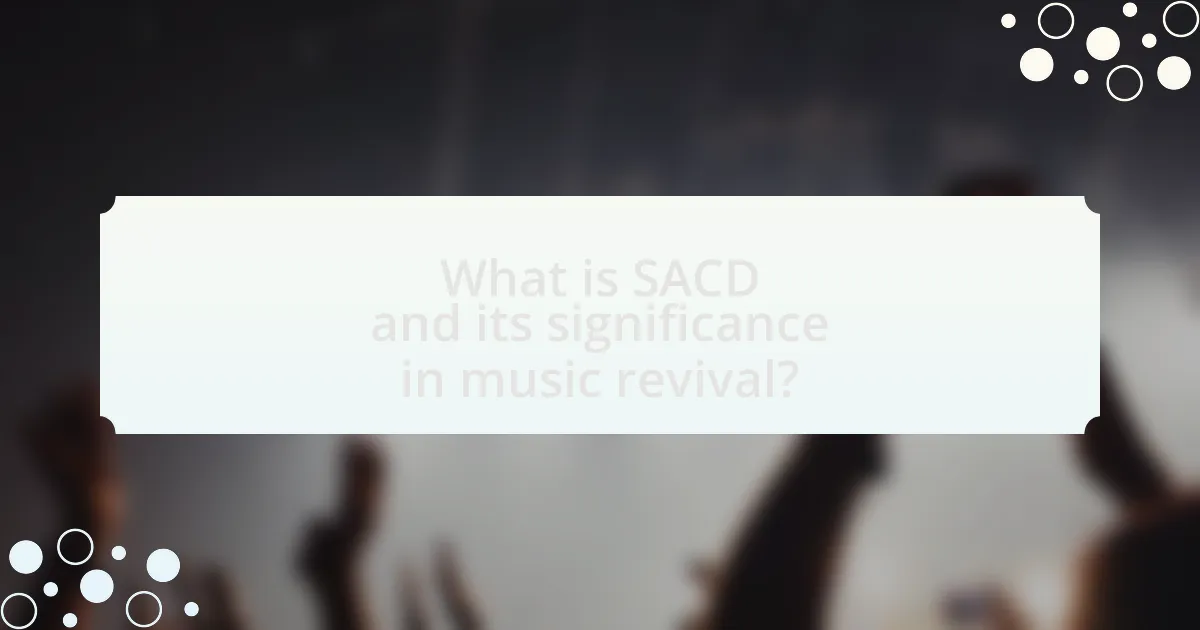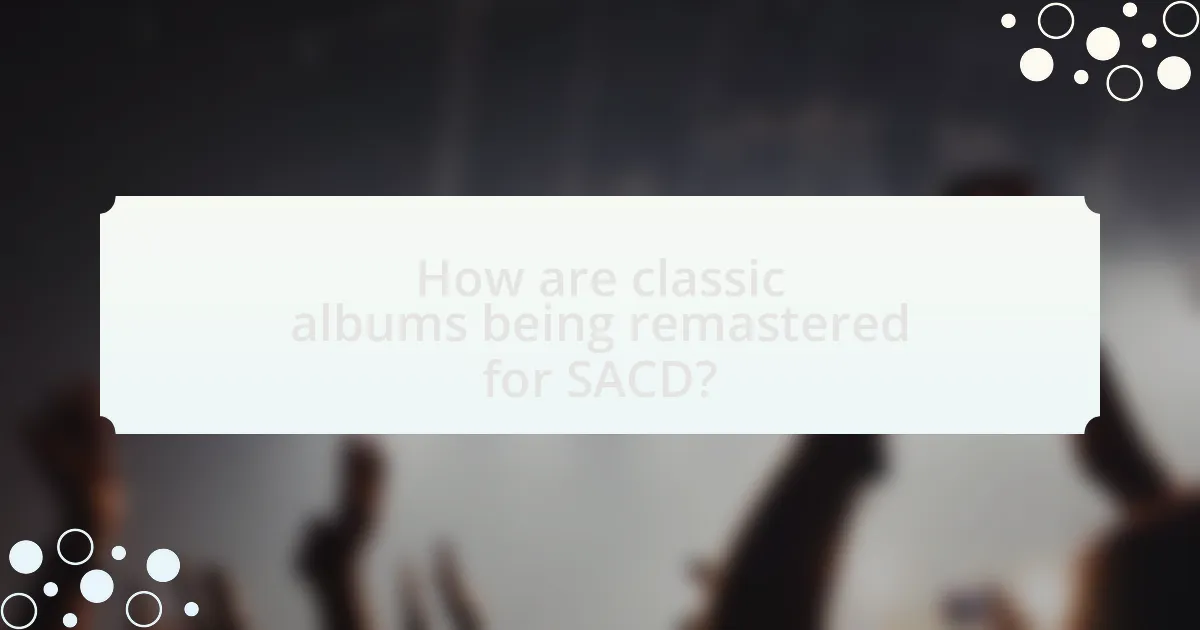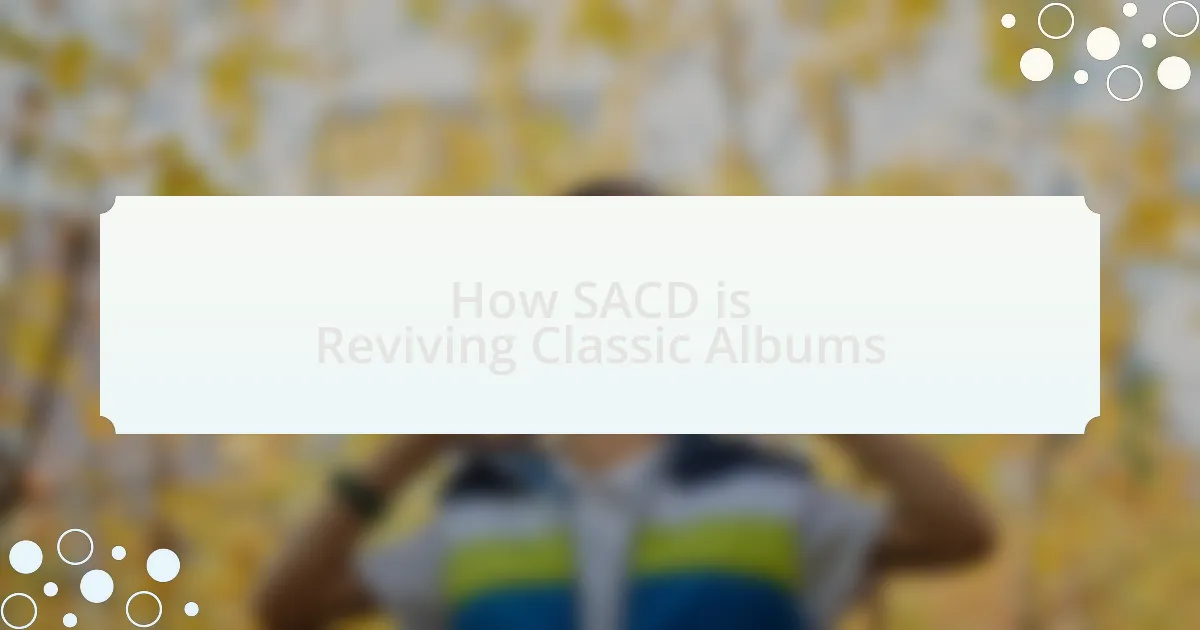SACD, or Super Audio CD, is a high-resolution audio format that significantly enhances sound quality, making it a vital tool in the revival of classic albums. This article explores how SACD’s superior audio fidelity and multi-channel capabilities attract audiophiles and music enthusiasts, allowing them to rediscover iconic recordings with greater detail and immersion. It discusses the technical advancements of SACD compared to traditional formats, the remastering process for classic albums, and the challenges faced by record labels in producing SACD releases. Additionally, the article highlights the impact of consumer demand on SACD’s market presence and offers insights on how listeners can optimize their experience with SACD albums.
What is SACD and its significance in music revival?

SACD, or Super Audio CD, is a high-resolution audio format that enhances sound quality beyond standard CDs. Its significance in music revival lies in its ability to provide a richer, more immersive listening experience, which appeals to audiophiles and music enthusiasts seeking to rediscover classic albums with superior fidelity. SACD supports multi-channel audio, allowing for a surround sound experience that can bring new life to older recordings, making them more relevant in today’s music landscape. This format has been instrumental in reissuing and remastering classic albums, thus preserving their legacy while attracting new listeners who appreciate high-quality sound.
How does SACD differ from traditional audio formats?
SACD, or Super Audio CD, differs from traditional audio formats primarily in its ability to deliver higher audio quality through a different encoding method. Unlike standard CDs that use PCM (Pulse Code Modulation) at a 16-bit/44.1 kHz resolution, SACDs utilize DSD (Direct Stream Digital) encoding, which operates at a 1-bit/2.8224 MHz rate. This allows SACDs to reproduce a wider dynamic range and greater detail in sound, resulting in a more immersive listening experience. Additionally, SACDs can support multi-channel audio, enabling surround sound formats that traditional CDs do not offer.
What technical advancements does SACD offer?
SACD, or Super Audio CD, offers several technical advancements, primarily high-resolution audio and multi-channel sound capabilities. The format supports audio sampling rates up to 2.8224 MHz, which is significantly higher than standard CDs, allowing for greater detail and clarity in sound reproduction. Additionally, SACD can encode audio in both stereo and multi-channel formats, providing an immersive listening experience that enhances the depth and spatial quality of music. These advancements are supported by the Direct Stream Digital (DSD) encoding method, which captures audio in a way that preserves the nuances of the original recording, making SACD a preferred choice for audiophiles and music enthusiasts.
Why is SACD considered superior for classic albums?
SACD is considered superior for classic albums due to its ability to deliver high-resolution audio and multi-channel sound. This format supports DSD (Direct Stream Digital) encoding, which captures audio with greater detail and fidelity compared to standard CDs. The enhanced audio quality allows listeners to experience the nuances of classical music, such as dynamic range and spatial imaging, more vividly. Additionally, SACDs often include both stereo and surround sound options, providing a richer listening experience that is particularly beneficial for orchestral works.
What role does SACD play in reviving classic albums?
SACD, or Super Audio CD, plays a significant role in reviving classic albums by providing high-resolution audio quality that enhances the listening experience. This format allows for multi-channel sound and superior fidelity compared to standard CDs, making it particularly appealing for audiophiles and collectors. The resurgence of interest in classic albums is often driven by the release of these titles in SACD format, which can include remastered versions that restore the original sound quality and dynamics. For instance, many iconic albums from the 1960s and 1970s have been reissued on SACD, attracting both new listeners and long-time fans, thereby revitalizing sales and interest in the original works.
How does SACD enhance the listening experience of classic albums?
SACD enhances the listening experience of classic albums by providing superior audio quality through its high-resolution audio format. This format supports multi-channel sound, allowing for a more immersive listening experience that captures the nuances of the original recordings. Additionally, SACD’s ability to deliver a wider dynamic range and greater frequency response compared to standard CDs results in clearer and more detailed sound reproduction. For instance, SACDs can reproduce frequencies up to 100 kHz, significantly higher than the 20 kHz limit of CDs, which allows listeners to experience the full depth and richness of classic albums as intended by the artists.
What impact does SACD have on the preservation of classic music?
SACD significantly enhances the preservation of classic music by providing superior audio quality and longevity compared to traditional formats. The high-resolution audio capabilities of SACD allow for a more accurate reproduction of the original recordings, capturing nuances that standard CDs cannot. This fidelity ensures that classic music is experienced as intended by the original artists and producers. Furthermore, SACDs are designed to be more durable than standard CDs, reducing the risk of degradation over time. This durability contributes to the long-term preservation of classic music, making it accessible for future generations.
How are classic albums being remastered for SACD?

Classic albums are being remastered for SACD through a process that involves high-resolution digital transfers and careful audio restoration techniques. This remastering typically starts with the original analog tapes, which are digitized at high sample rates, often 24-bit/192 kHz, to capture the full dynamic range and detail of the recordings. Engineers then apply various restoration methods to eliminate noise and enhance sound quality, ensuring that the final product meets the standards of SACD’s Super Audio CD format, which supports both stereo and multi-channel audio. The remastered tracks are then encoded in DSD (Direct Stream Digital) format, which is specifically designed for SACD, preserving the nuances of the original recordings while providing an improved listening experience.
What are the steps involved in remastering classic albums for SACD?
The steps involved in remastering classic albums for SACD include sourcing the original master tapes, digitizing the audio at high resolution, applying audio restoration techniques, mixing and mastering for SACD specifications, and finally, creating the SACD disc.
Sourcing the original master tapes ensures the highest quality audio is used, as these contain the best representation of the recording. Digitizing the audio at high resolution typically involves converting the analog signal to a digital format at a minimum of 24-bit/192 kHz, which captures more detail than standard CD quality. Audio restoration techniques may include noise reduction, equalization, and dynamic range adjustments to enhance the listening experience while preserving the original sound.
Mixing and mastering for SACD specifications involves preparing the audio for the Super Audio CD format, which supports both stereo and multi-channel audio, ensuring compatibility with SACD players. Finally, creating the SACD disc involves encoding the audio into the SACD format and producing the physical discs for distribution. This process is crucial for reviving classic albums, as it allows them to be experienced in a modern, high-fidelity format.
How does the remastering process differ from standard CD remastering?
The remastering process for SACD differs from standard CD remastering primarily in the audio resolution and format used. SACD utilizes a higher sampling rate and bit depth, specifically DSD (Direct Stream Digital) technology, which captures audio at a rate of 2.8224 MHz, compared to the 44.1 kHz of standard CDs. This results in a more detailed and dynamic sound reproduction, allowing for a richer listening experience. Additionally, SACD remastering often involves a more extensive use of analog equipment and techniques, which can enhance the warmth and depth of the audio, further distinguishing it from the more straightforward digital processes typically employed in standard CD remastering.
What technologies are used in the remastering of classic albums?
The technologies used in the remastering of classic albums include digital audio workstations (DAWs), high-resolution audio formats, and advanced audio restoration software. Digital audio workstations allow engineers to manipulate sound with precision, enabling enhancements in clarity and dynamics. High-resolution audio formats, such as SACD (Super Audio CD), provide greater detail and fidelity compared to standard formats, making them ideal for remastering. Advanced audio restoration software, like iZotope RX, is employed to eliminate noise, clicks, and other imperfections, ensuring a cleaner final product. These technologies collectively enhance the listening experience of classic albums, preserving their legacy while improving sound quality.
Why are record labels investing in SACD releases of classic albums?
Record labels are investing in SACD releases of classic albums to capitalize on the growing demand for high-fidelity audio experiences among audiophiles and collectors. The Super Audio CD format offers superior sound quality compared to standard CDs, providing a more immersive listening experience that appeals to consumers seeking enhanced audio fidelity. Additionally, the resurgence of interest in vinyl and physical media has created a market for premium formats like SACD, allowing labels to attract both nostalgic listeners and new fans. This investment is supported by the fact that SACD sales have shown a steady increase, indicating a viable market for classic albums reissued in this high-quality format.
What market trends support the revival of classic albums through SACD?
The revival of classic albums through SACD is supported by increasing consumer demand for high-fidelity audio formats and a growing interest in nostalgia-driven music experiences. The market has seen a resurgence in vinyl sales, with the Recording Industry Association of America reporting that vinyl sales reached a 30-year high in 2020, indicating a strong consumer preference for physical media. Additionally, the rise of audiophile communities and forums has created a niche market that values superior sound quality, which SACD provides through its advanced audio technology. This trend is further reinforced by the limited edition releases of classic albums on SACD, appealing to collectors and music enthusiasts who seek both quality and exclusivity.
How does consumer demand influence SACD releases?
Consumer demand significantly influences SACD releases by dictating which classic albums are prioritized for remastering and distribution. Record labels analyze sales trends, streaming data, and consumer preferences to identify high-demand titles, leading to the release of SACDs that cater to specific audience interests. For instance, the resurgence of interest in vinyl and high-fidelity formats has prompted labels to invest in SACD versions of popular albums, as evidenced by the reissues of iconic titles like “Dark Side of the Moon” and “Rumours,” which have seen increased sales due to consumer enthusiasm for enhanced audio quality. This trend demonstrates that consumer demand directly shapes the SACD market, ensuring that releases align with listener preferences for nostalgia and superior sound.
What are the challenges and criticisms of SACD in reviving classic albums?

The challenges and criticisms of SACD in reviving classic albums include limited consumer adoption, high production costs, and the perception of marginal audio improvement over existing formats. Despite its superior sound quality, SACD has struggled to gain a significant market share, with many consumers preferring more accessible formats like CD or digital downloads. Additionally, the production costs associated with remastering and releasing albums in SACD format can deter record labels from investing in this medium, especially when the potential return on investment is uncertain. Critics also argue that the differences in audio quality may not be noticeable to the average listener, leading to skepticism about the necessity of SACD for classic album revivals.
What are the common criticisms of SACD as a format?
Common criticisms of SACD as a format include its limited mainstream adoption, high production costs, and compatibility issues with standard CD players. The format has struggled to gain widespread popularity due to the prevalence of digital downloads and streaming services, which offer more convenience and accessibility. Additionally, the production costs associated with SACD releases are often higher than traditional CDs, making it less appealing for record labels. Furthermore, SACD’s requirement for specific playback equipment creates compatibility challenges, as many consumers do not own SACD-compatible players, limiting the audience for these high-resolution audio discs.
How do these criticisms affect the perception of SACD among audiophiles?
Criticisms of SACD, such as its limited catalog and high cost, negatively impact its perception among audiophiles. Many audiophiles view SACD as a niche format, leading to skepticism about its value compared to other high-resolution audio formats. This skepticism is reinforced by the perception that SACD lacks widespread support from record labels, which limits the availability of desirable titles. Consequently, these factors contribute to a diminished enthusiasm for SACD within the audiophile community, as many enthusiasts prioritize formats with broader selections and better affordability.
What challenges do record labels face in producing SACD versions?
Record labels face significant challenges in producing SACD versions, primarily due to high production costs and the need for specialized equipment. The manufacturing process for SACDs is more expensive than traditional formats, requiring investment in both hardware and software that can handle the DSD (Direct Stream Digital) format. Additionally, record labels must navigate the complexities of licensing and remastering older recordings, which often involves negotiating rights with multiple stakeholders. The limited consumer demand for SACDs compared to more mainstream formats like CDs and digital downloads further complicates the financial viability of producing these high-fidelity discs.
How can listeners best experience SACD versions of classic albums?
Listeners can best experience SACD versions of classic albums by using a high-quality SACD player and a compatible audio system that supports multi-channel audio. A dedicated SACD player ensures optimal playback of the high-resolution audio formats that SACDs offer, which can include both stereo and multi-channel sound. Additionally, utilizing a surround sound system enhances the immersive experience, allowing listeners to appreciate the depth and clarity of the audio. Research indicates that SACDs can provide a dynamic range and sound quality superior to standard CDs, making the investment in quality equipment worthwhile for an enhanced listening experience.
What equipment is necessary for optimal SACD playback?
To achieve optimal SACD playback, a dedicated SACD player is essential. These players are designed to read the high-resolution audio formats of SACDs, ensuring the best sound quality. Additionally, a high-quality audio system, including an amplifier and speakers capable of handling the extended frequency range of SACD, is necessary to fully appreciate the audio fidelity. Using HDMI connections can also enhance the audio signal transfer from the player to the amplifier, further improving playback quality.
What tips can enhance the listening experience of SACD albums?
To enhance the listening experience of SACD albums, listeners should invest in high-quality audio equipment, including a dedicated SACD player and premium speakers. High-quality equipment ensures that the superior audio resolution of SACD, which can reach up to 6.1 MHz in DSD format, is fully realized, providing a more immersive sound experience. Additionally, listeners should consider the acoustics of their listening environment; optimizing room acoustics can significantly improve sound clarity and depth. Using high-quality cables and ensuring proper speaker placement further enhances audio fidelity, allowing the listener to appreciate the nuances and details in the music that SACD formats are designed to deliver.

Leave a Reply